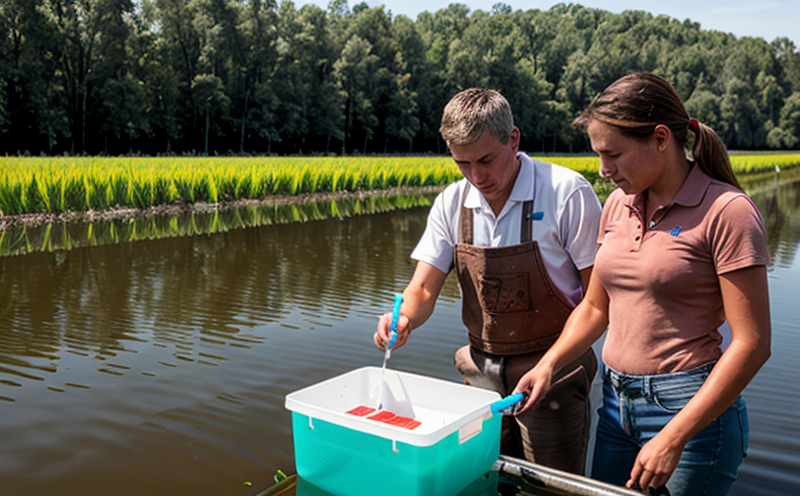Biochemical Oxygen Demand (BOD) Testing in Agricultural Water
In agricultural water quality testing, biochemical oxygen demand (BOD) is a critical parameter used to assess the organic pollution content within irrigation and runoff waters. This test measures the amount of dissolved oxygen that microorganisms consume as they break down organic matter present in water samples over a specified period. Understanding BOD levels helps ensure that agricultural practices do not degrade water quality, which can have far-reaching impacts on both environmental health and crop productivity.
Water contaminated with excessive organic material can lead to several detrimental effects such as reduced oxygen levels in aquatic ecosystems, promoting anaerobic conditions that are harmful to fish and other organisms. Moreover, high BOD concentrations indicate the presence of pollutants derived from agricultural runoff, including fertilizers, pesticides, and livestock waste. By monitoring these parameters, farmers and quality managers can make informed decisions regarding best management practices (BMPs) aimed at reducing pollution and maintaining sustainable water resources.
The standard method for determining BOD involves incubating a water sample at 20°C for five days, although variations exist depending on the specific application. During this time, microorganisms decompose organic matter in the presence of dissolved oxygen, causing a reduction in available oxygen levels which is then measured accurately using appropriate instrumentation.
For accurate results, proper specimen preparation is essential; this typically includes diluting raw samples to avoid exceeding the detection limits of analytical equipment. Once prepared, the sample undergoes rigorous testing using advanced analytical techniques such as closed respirometry or automated biochemical analyzers that provide precise measurements within minutes.
The importance of adhering to international standards cannot be overstated when conducting BOD tests in agricultural settings. Compliance with ISO 6020 ensures reliability and consistency across different laboratories, allowing for meaningful comparisons between results obtained by various entities. Similarly, ASTM D5959 provides guidance on selecting appropriate methods based on the type of water being analyzed (surface or ground).
Understanding how BOD relates to other parameters like total suspended solids (TSS) or coliform bacteria can further enhance our comprehension of overall water quality issues within agricultural environments. For instance, elevated TSS levels may indicate sedimentation caused by erosion while increased coliform counts suggest fecal contamination – both phenomena could contribute significantly to higher BOD readings.
Given the complexity involved in interpreting BOD data correctly, it’s crucial for those responsible for managing water resources in agriculture to receive comprehensive training on proper sampling techniques and interpretation of results. Additionally, integrating real-time monitoring systems into irrigation networks can help track changes in water quality over time, providing valuable insights that inform proactive interventions designed to mitigate potential risks associated with poor water management.
Applied Standards
The biochemical oxygen demand (BOD) test for agricultural waters follows internationally recognized standards such as ISO 6020 and ASTM D5959. These guidelines provide clear procedures on sample collection, preparation, and analysis to ensure accuracy and consistency across various testing environments.
| Standard Number | Description |
|---|---|
| ISO 6020 | Guidelines for the Determination of BOD in Water and Wastewater |
| ASTM D5959 | Standard Practice for Sampling and Preservation of Dissolved Oxygen Samples from Waste Water and Surface Water |
Benefits
- Identifies sources of organic pollution in irrigation water
- Aids in compliance with environmental regulations regarding water quality
- Promotes sustainable farming practices by minimizing negative impacts on ecosystems
- Ensures reliable data for decision-making related to crop health and productivity
Biochemical Oxygen Demand (BOD) testing offers numerous advantages, particularly when applied within agricultural settings. By identifying organic pollutants early through this process, farmers can take corrective actions promptly to prevent further contamination of local water bodies. Compliance with regulatory requirements becomes easier as consistent measurement methods are used throughout the industry. Moreover, improved understanding of water quality enables better resource allocation for irrigation purposes, ultimately leading to enhanced crop yields and healthier plant growth.
Industry Applications
Biochemical Oxygen Demand (BOD) testing plays a vital role in various sectors within agriculture and forestry. It is widely used by regulatory bodies responsible for enforcing water quality standards, ensuring that agricultural activities do not cause excessive pollution of freshwater resources. Additionally, this test serves as an essential tool for researchers studying the effects of climate change on soil health and plant resilience.
| Agricultural Sector | Description |
|---|---|
| Irrigation Management | Evaluating suitability of different water sources for use in irrigation systems |
| Livestock Farming | Monitoring runoff from feedlots and animal housing areas to prevent contamination |
| Crop Protection Programs | Assessing the impact of pesticides on nearby water bodies before application |
| Aquaculture | Determining optimal stocking densities based on available dissolved oxygen levels in ponds or tanks |
Beyond these applications, BOD testing also finds relevance in forestry management. For example, it helps evaluate the effectiveness of reforestation projects by measuring changes in water quality after tree planting activities have taken place.





